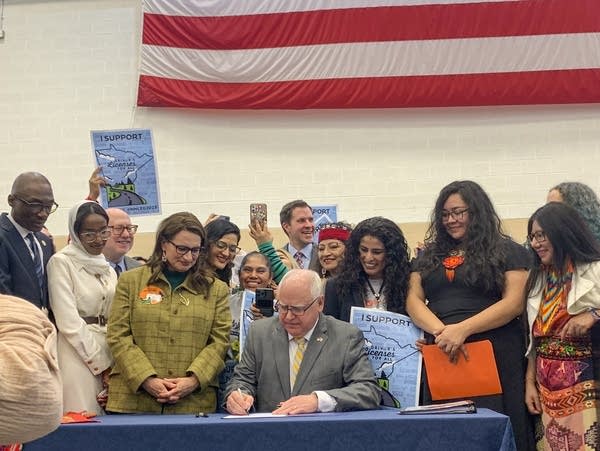Spanish-language tests spiked since passage of Driver’s License for All law

Go Deeper.
Create an account or log in to save stories.
Like this?
Thanks for liking this story! We have added it to a list of your favorite stories.
Data suggests a large number of Minnesotans have taken advantage of a new state law allowing them to apply for a driver’s license regardless of their immigration status.
The Driver’s License for All law, which took effect Oct. 1, eliminated the need to show proof of legal presence in the U.S. to get a standard Minnesota driver’s license or ID card.
About 81,000 Minnesotans lacking permanent legal status became eligible for a driver’s license. They still must provide proof of identity, and pass the written knowledge and behind-the-wheel exams.
In the first six months after the law took effect, the number of written driver’s exam tests taken jumped by 44 percent from the same six-month period the previous year, according to data provided by the Department of Public Safety.
Turn Up Your Support
MPR News helps you turn down the noise and build shared understanding. Turn up your support for this public resource and keep trusted journalism accessible to all.
By far, the biggest spike — an increase of more than 10 times — was in Spanish language tests, from 7,008 from October 2022 to March 2023, to 72,417 from October 2023 to March 2024. There were also smaller increases in tests administered in Vietnamese, Somali and Hmong. The numbers could reflect people who take the test more than once.
The Driver’s License for All law was backed by law enforcement, faith and business groups and immigrant rights advocates, who maintained it would improve public safety by ensuring that all drivers are licensed and insured.
“The positive thing about seeing an increase in numbers is how many people really want to make sure they are licensed and driving legally, that people see that as an important thing for themselves to do now that they’re able to,” said Julia Decker, policy director at the Immigrant Law Center of Minnesota.
State officials can’t say for sure how much of the increase in driver’s tests can be attributed to the new law, but they assume it’s a major factor, said Jody-Kay Peterson, driver and vehicle services program director for DPS.
The jump in test-taking was bigger than expected, Peterson said. State officials had estimated that about 20 percent of those eligible who are over age 16 would apply in the first year, but it’s been more than that, she said.
“We’re doing the best that we can with keeping up, and we’re certainly learning a lot as we continue to go through this process,” she said. “Of course, there’s certainly room for improvement.”
DPS received funding to hire 12 new examiners and additional staff to review applications, Peterson said. That’s helped address an ongoing statewide challenge of finding open appointment times for driver’s exams, she said.
Data from the first six months since the law’s adoption show that some applicants have struggled to pass the exam. Nearly three-fourths of those who took the written knowledge test in Spanish between October and March failed. That’s higher than the statewide failure rate of 59 percent.
Peterson said that could be due to a combination of factors. Some test takers might have difficulty translating the Latin American version of Spanish on the test. Others just might need more time to prepare, she said.
“Definitely studying and being prepared for the test could better improve the pass rate,” Peterson said. “We do see some individuals come to us really not prepared, especially for the road test, and you can tell that they haven’t done enough practice time on the road.”
DPS is launching new videos and other materials to help test takers prepare. Community groups also have organized study sessions or workshops to review the manual.
Overall, the rollout of the law has gone relatively smoothly, Decker said. As with any significant law change, there’s been a learning curve, she said, as both government officials and residents figure out the new process.
“Nobody really likes going to the DMV to deal with driver’s license issues,” she said. Decker said it required some explaining to community members that, “Yes, there will be long wait times. Yes, it will require additional documents, and it won’t just be a snap of the fingers.”
The law expanded the list of items that a resident can provide to show proof that they live in Minnesota, including a foreign passport, foreign birth certificate or adoption certificate.
The rollout of information since the law’s passage has been a bit confusing, said Claudia Lainez with the nonprofit organization COPAL, or Communities Organizing Latine Power and Action.
In some cases, people who went to their local driver’s license office were still asked for proof of lawful U.S. residency, Lainez said. People also have had trouble finding openings for exams or have had to drive a long distance for an appointment, she said.
“I guess it’s getting better,” Lainez said. “It is something new, so we were kind of expecting that. And I think everybody’s adjusting to the process.”
As for whether the law is achieving its goal of improving public safety, it’s too early to tell in terms of crash or insurance statistics, Decker said.
“The danger of that is looking at different rates and saying, ‘Oh well, obviously it had to do with this new law that came into effect,’ versus other issues that could have also caused a difference in the rates,” she said. “But I do think it will be interesting, maybe at the one-year, five-year, 10-year mark, to see what sort of effect, if any, there has been.”
Eighteen other states and the District of Columbia grant licenses to residents regardless of immigration status.


